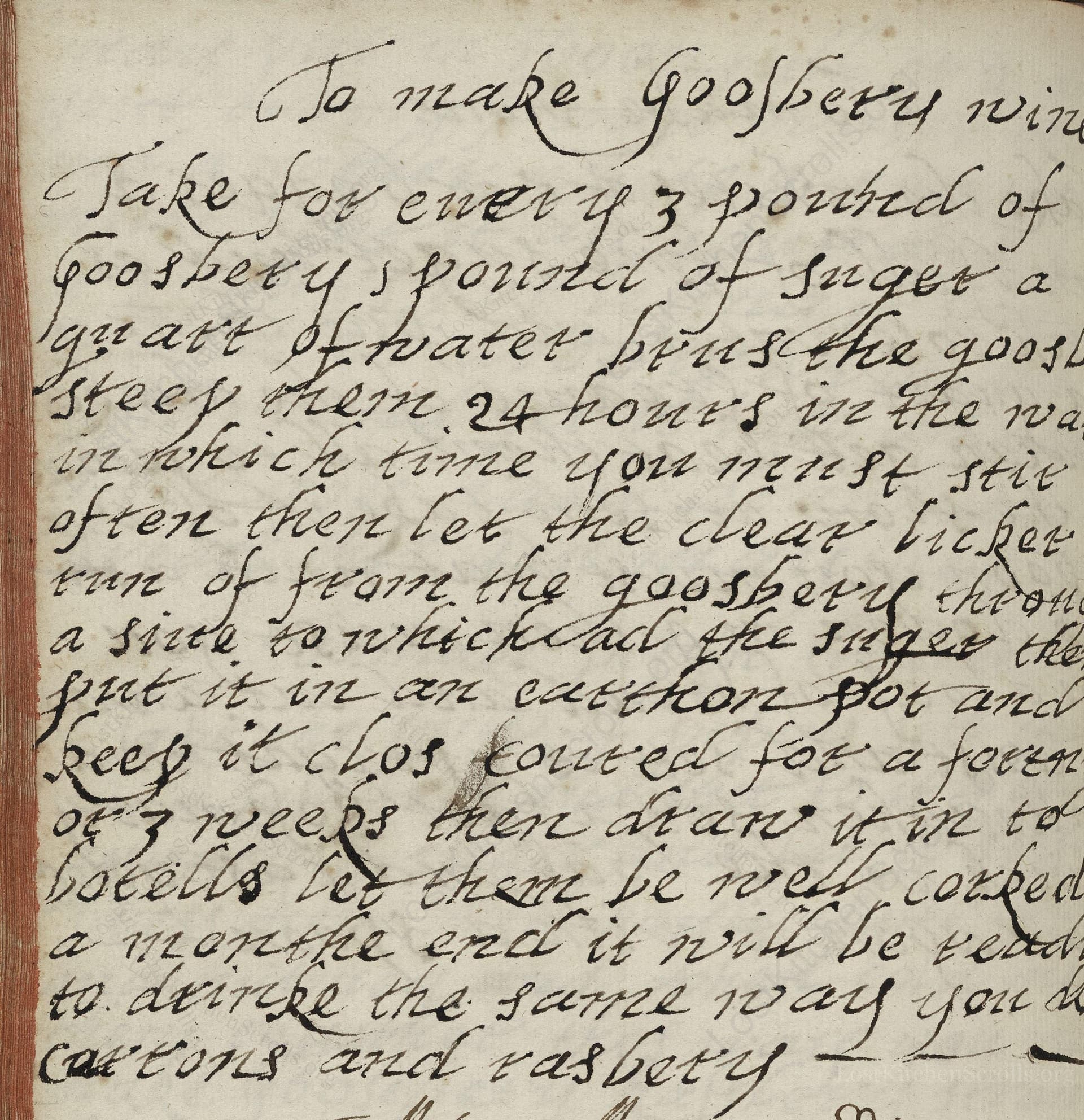To Make Gooſberry Wine
From the treasured pages of Cookbook of Constance Hall
Written by Constance Hall

To Make Gooſberry Wine
"Take for every 3 pound of gooſberry 3 pound of suger a quart of water bruise the gooſberry steep them 24 hours in the water in which time you must stir it often then let the clear licker run of from the gooſberry through a sieve to whickad the suger then put it in an earthen pot and keep it clos covered for a forenight or 3 weeks then draw it in to botells let them be well corped a monthe and it will be ready to drincke the same way you doe carcons and rasberry - 2 -"
Note on the Original Text
The recipe is written in the style of practical instruction, assuming basic household knowledge. Measurements, like 'pound' and 'quart', were common in English kitchens; today, we translate these to metric units for clarity. Spelling, such as 'Gooſberry' (with a long s) and 'suger', reflects the orthography of the time—grammar was less standardized, and recipes often ran in one long sentence, focusing on the sequence of actions more than prose style. The instruction to keep the pot 'clos covered for a forenight or 3 weeks' is a cue for fermentation, with times adjusted by household conditions and intuition.

Title
Cookbook of Constance Hall (1672)
You can also click the book image above to peruse the original tome
Writer
Constance Hall
Era
1672
Publisher
Unknown
Background
A spirited foray into 17th-century kitchens, this collection by Constance Hall brims with the flavors, secrets, and delicacies of Restoration-era England—perfect for cooks keen to revive a dash of history in their modern menus.
Kindly made available by
Folger Shakespeare Library
This recipe was documented by Constance Hall in 1672, a time when home winemaking was a practical necessity for many households. Gooseberries were widely grown in English gardens, valued for their tartness. Sugar, though a luxury, had become more accessible in the 17th century, making fruit wines increasingly popular for preserving the harvest and creating festive beverages. Wine recipes like this reflect a time when women’s domestic knowledge was central to the home’s sustenance and hospitality. This recipe is part of a broader manuscript tradition: handwritten collections where generations recorded their best culinary and medicinal knowledge.

Originally, the wine would have been made using a large earthenware or stoneware pot for maceration and fermentation—glass was too expensive and rare for common kitchens. A wooden or metal stirring stick was used to mix. Straining was accomplished with a coarse sieve or linen cloth. Bottling used heavy glass bottles, sealed with cork and wax, often reusing bottles from other beverages.
Prep Time
15 mins
Cook Time
0 mins
Servings
6
We've done our best to adapt this historical recipe for modern kitchens, but some details may still need refinement. We warmly welcome feedback from fellow cooks and culinary historians — your insights support the entire community!
Ingredients
- 3 lbs gooseberries (fresh)
- 3 lbs granulated sugar
- 1 quart water
Instructions
- To make Gooseberry Wine, take an equal weight of fresh gooseberries and sugar—3 lbs of gooseberries to 3 lbs of sugar.
- Wash and roughly crush the gooseberries.
- Combine with 1 quart of water in a large bowl or non-reactive pot, and let the fruit soak for 24 hours, stirring often.
- After 24 hours, strain the mixture through a sieve to separate the liquid from the solids.
- Stir the sugar into the liquid until dissolved.
- Transfer this sweetened juice to a large glass or ceramic fermenting vessel.
- Cover and leave to ferment in a cool, dark place for 2 to 3 weeks.
- After fermentation, carefully decant into clean bottles and seal tightly.
- Let the bottles mature for a month before drinking, as you would homemade currant or raspberry wine.
Estimated Calories
240 per serving
Cooking Estimates
It takes about 15 minutes to prepare the gooseberries and sugar, and about 1 minute to dissolve the sugar after soaking. There is no actual cooking involved, just soaking and fermenting. The recipe makes about 6 servings, with each serving containing around 240 calories from the sugar.
As noted above, we have made our best effort to translate and adapt this historical recipe for modern kitchens, taking into account ingredients nowadays, cooking techniques, measurements, and so on. However, historical recipes often contain assumptions that require interpretation.
We'd love for anyone to help improve these adaptations. Community contributions are highly welcome. If you have suggestions, corrections, or cooking tips based on your experience with this recipe, please share them below.
Join the Discussion
Rate This Recipe
Dietary Preference
Main Ingredients
Culinary Technique

Den Bockfisch In Einer Fleisch Suppen Zu Kochen
This recipe hails from a German manuscript cookbook compiled in 1696, a time whe...

Die Grieß Nudlen Zumachen
This recipe comes from a rather mysterious manuscript cookbook, penned anonymous...

Ein Boudain
This recipe comes from an anonymous German-language manuscript cookbook from 169...

Ein Gesaltzen Citroni
This recipe, dating from 1696, comes from an extensive anonymous German cookbook...
Browse our complete collection of time-honored recipes



